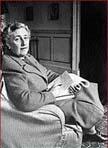
I’ve made it clear that I love a good mystery, and there are few that I enjoy more than those of Agatha Christie. Whenever someone asks me who my favorite author is, frequently I name Dame Agatha, partially because I enjoy watching the shocked expression on the faces of people who expected a more “highbrow” response from me. I belong to that small but strident group of people who believe that The Murder of Roger Ackroyd is one of the most innovative books of the early 20th century, forever altering the conventions of storytelling.
But I am digressing, because this review is not about Christie’s mystery novels, but instead about her lesser-known books.
Christie had wanted to write outside the whodunit genre for a long time, but her publishers dissuaded her, telling her to stick to the tried-and-true moneymakers.
But Christie never stopped desiring to stretch her boundaries, and she eventually wrote six “straight novels” under the pseudonym of Mary Westmacott. These were out of print for a long time, but they’ve recently been republished in two three-book anthologies.
Some are much better than others, but each has something to recommend itself for Christie fans. Most critics consider these her most personal works, and they are required reading for anyone with an interest in Christie’s life and mentality.
Most of them pivot around their female characters. The early ones reflect her youthful plans, hopes, and ambitions. The later ones deal with more mature women and their discomfort with a world that often has no comfortable place for them.
Christie’s first effort outside the mystery genre was Giant’s Bread the story of an aspiring composer and his often-disastrous personal life. It has its share of contrivances and clichs, but it’s entertaining. Everyone who’s studied Christie’s life is aware of her mysterious 11-day-long disappearance in the mid-1920s following the breakup of her first marriage, which was subsequently attributed to amnesia brought on by stress.
This adds an interesting dimension to the plotline where the protagonist’s friends try to help cure his amnesia and help him reclaim his old life.
A Daughter’s A Daughter is a novelized adaptation of one of Christie’s plays. The conversion is a little obvious. Not only is the majority of the book stage bound to the heroine’s living room, but the bulk of the book is dialogue and the novel’s even divided into thirds, the first two ending in a cliffhanger climax, so it’s very clear that this is a refurbished three-act play.
The storyline revolves around a single mother, her daughter, and their oppressive influences on one another’s romantic lives. It’s the colorful supporting characters that make the read worthwhile.
The Burden focuses on the relationship between two sisters, the elder overprotective and controlling toward her little sister. There’s a disastrous marriage, adultery, despair, alcoholism, even a murder. This is by far the darkest of the Westmacott novels, and the one with the most ambiguous and least satisfying ending.
These three are my least favorite Westmacott novels. I still like them, and they’re definitely worth a look if you’re interested, but they pale in comparison to the other three.
The Rose and the Yew Tree, about an opportunist politician and his attempts to weasel his way into social acceptance and win the object of his obsession, is considered by many critics to be the best of the Westmacott novels. Most of the Westmacott stories revolve around people in various states of emotional and moral decay, but this one is about the only one where the characters seem to get a real shot at redemption.
Rose is good, but my favorites are Absent in the Spring and Unfinished Portrait.
Absent is about a seemingly content woman marooned in a hotel in the desert. With nothing to read (always a bad thing) she finally gets a chance to step aside and look at her life critically. Realizations and revelations come along, and part of the enjoyableness of the book comes from the fact that the disclosures are usually blatantly obvious to the reader, but completely obscured to the heroine until prolonged contemplation.
Finally, she has to choose between facing the truth or clinging to her neat, ordered, but ultimately artificial world.
It’s hazardous to call any novel autobiographical, but Unfinished Portrait is pretty much a carbon copy of the first half of Christie’s life, and none the worse for that. I read Portrait six years after reading Christie’s autobiography, and throughout the first 25 pages of reading Portrait I had a case of dj vu until I finally realized that Christie was drawing heavily from her own life.
Some critics have charged Christie with not looking at her own life and actions with the honest scrutiny of her absent heroine, but I still feel that this is the best of the bunch.
Still, I suggest reading Agatha Christie: An Autobiography before any of the Westmacott novels. It is long, drawn out, and one of the most charming personal memoirs I have ever read. Not only is it a great insight into Christie’s mind and life, but it also is one woman’s perspective of England and how it changed from the end of the Victorian era through the world wars to the mid-70s.
Also not to be missed is Come, Tell Me How You Live, Christie’s travel memoir about her experiences in the Middle East with her second husband, an archaeologist. Christie recounts her battles with desert rats, vermin, disgruntled employees, and all sorts of inconveniences. It’s a lot of fun.
Christie’s star has been on the rise in recent years, primarily as a feminist icon. Throughout the 19th and early 20th centuries, the “lady novelist” was a derided figure of fun, considered almost subhuman by many males. Christie’s phenomenal success, combined with the efforts of several other literary women, helped to abolish that stereotype.
More readers need to take a closer look at the life of the woman who created Hercule Poirot and Miss Marple.
